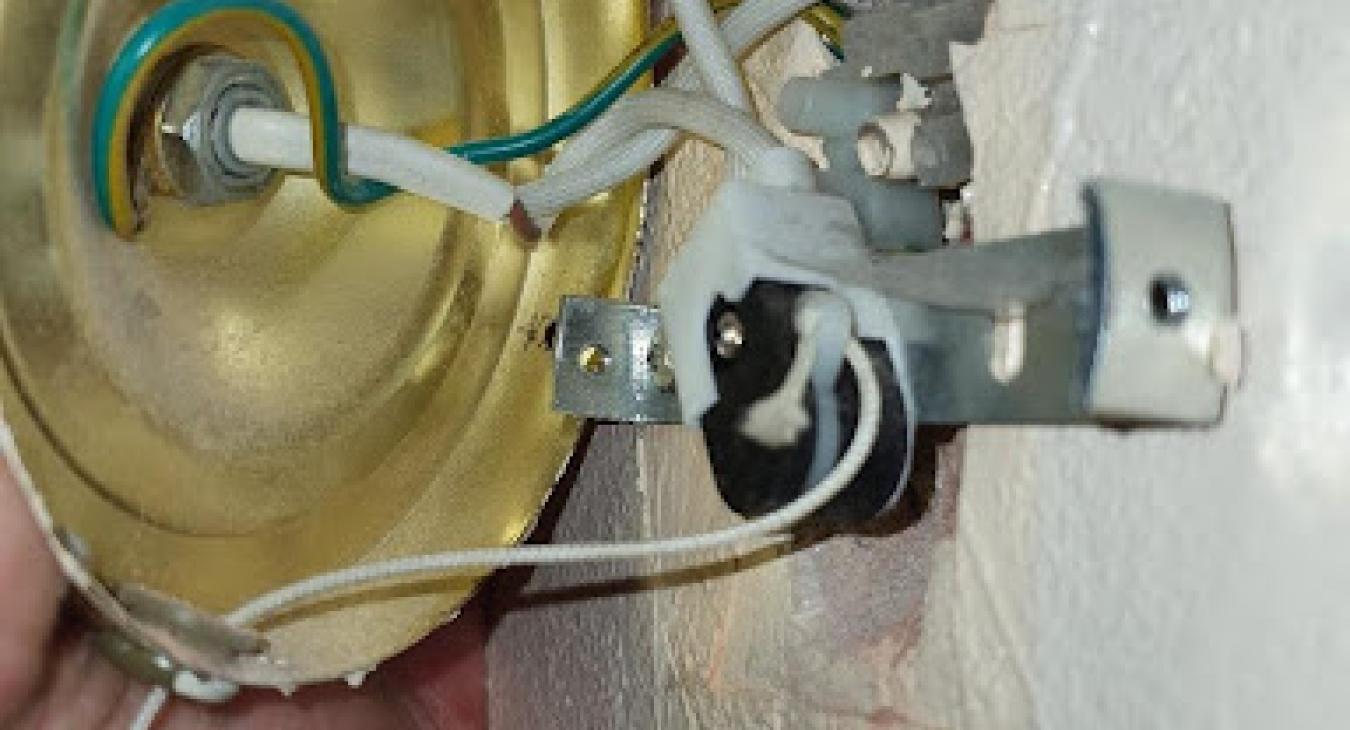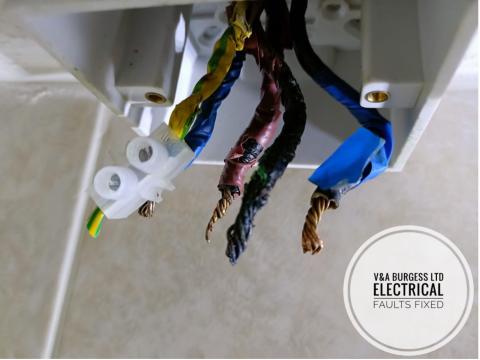
Table of Contents
- There are many jobs that electricians carry out on a regular basis - from rewiring to adding a plug socket.
- Electrician Jobs
- Adding More Plug Sockets
- Adding More Lights
- New Electrical Circuit Installation
- Rewire
- Bathroom Electrical Works
- DIY Jobs
- Rewiring A Plug Safely
- Resetting A Trip Switch
- Changing The Fuse In A Plug
There are some electrician jobs & some jobs you might be able to DIY (emphasis on might!) In this blog we'll go through the typical jobs that should be left to an electrician and those that can be carried out safely in a DIY manner. We can see in the photograph that these metal wall lights that require earthing have not been connected as the cable feeding them is so old that it does not even have an earth wire! This is a job for an electrician to fix.
Back to top2) Electrician Jobs
- Adding more plug sockets
- Adding more lights, e.g., spotlights
- New electrical circuit installation
- Rewire
- New Fuse box / consumer unit
- Bathroom electrical works
- DIY JOBS
- Visually checking the condition of electrical equipment without removal
- Rewiring a plug safely (see our blog on this here:)
- Resetting a trip switch
- Changing the fuse in a plug
As we can see, there are a number of jobs that should not be performed by DIYers and those that can should only be carried out if you are competent, have the right tools and equipment and are safe to do so. Let’s look at what’s involved in the ELECTRICIAN JOBS first.
Back to top3) Adding More Plug Sockets
When more plug sockets are required in the home then there are a number of considerations that have to be made before the work can start. Various electrical checks and tests will need to be performed on the circuit in order to comply with BS7671 wiring regulation 132.16 and other wiring regulations. The current condition of the electrical system will need to be ascertained ensuring that the Main Equipotential Bonding (safety earth connections to pipework typically) will need to be checked to ensure it is adequate. The circuit to be extended must also be checked to ensure that the circuit protective conductor is adequately sized and in place at every point. The line and neutral conductors should be checked for continuity and expected resistance values are comparable with those measured during testing. The electric shock protection (RCD) must also be checked to ensure that it is the correct type of protection for the circuit being extended. If the device is too old then it must be exchanged for the most up to date type of device. Once the electrician is happy with the type of RCD, they then must test the device to ensure that, in the event of an electrical fault, it will trip in the required time. Once these checks have been made and it is determined that compliance with BS7671 wiring regulations can be met then the circuit can safely be extended and the new plug sockets installed.
Occasionally a consumer unit will need to be replaced before this type of work can safely and legally be carried out. This is something to bear in mind if you are looking for quotes on extending an old electrical system. The photograph shows an old fuse box that should now be replaced before further electrical works are carried out. Whilst older consumer units are sometimes still sufficient for existing electrical installations, it is not acceptable to introduce new circuits, circuit extensions or alterations to a wiring system of this age without bringing the system up to modern safety regulations standards. Appropriate certification should be carried out to prove the work has been done safely and the installer is named on the paperwork. This is a requirement under the wiring regulations.
Back to top4) Adding More Lights
Similarly, when extending the electrical circuit for plug sockets, various checks must be carried out on the lighting circuit to ensure that the earthing and resistances are correct before extending the circuit. Should there be any issues during the testing part of the job then these will need to be rectified before the circuit can safely be extended. Adding additional cable to a circuit to feed spotlights bring with it the requirement to ensure that all junctions are made correctly. If junctions are to be buried or inaccessible then they must be made Maintenance Free in accordance with the wiring regulations. This carries a set of requirements that need to be followed to prevent there being issues with any hidden wiring connections. Where junctions are to be made, they must also ensure that no single cable insulation is visible outside of any electrical enclosure to minimise the risk of electric shock and damage to the wiring. Where additional spotlights are to be installed, they must comply with any requirements of the installation location for instance a bathroom should have suitably rated IP fittings to ensure that they will survive the environment and not introduce and danger to the users of the electrical system. The earthing and pipework earthing will also be checked. Lighting circuits of a certain age, often contained no circuit protective conductor (earth wire) and adding to this type of cabling is now unacceptable. There should be a circuit protective conductor at every switch and light fitting. Appropriate certification should be filled out as is the requirement under the wiring regulations.
Back to top5) New Electrical Circuit Installation
This is most definitely one of those ELECTRICIAN JOBS where only a professional will do. Designing a new circuit is a skill that requires experience, knowledge, and competency. New circuits are typically used when installing items like electric showers, Electric Vehicle Chargers and supplies to outbuildings. The earthing of the installation along with safety earthing to pipework will be checked. The capacity of the existing supply equipment and consumer unit will also be verified to ensure that the electrical system will cope with the increased electrical demand. When designing the new electrical circuit the electrician must consider the length of the circuit, the expected design current (load that will be placed on the circuit) and expected voltage drop on the circuit. Once these considerations have been made the circuit can be installed into the building. Careful consideration during design and install will ensure trouble free operation for the life of the circuit. Thermal insulation, grouping with other circuits and cable installation method can all affect the ability of the circuit to operate correctly and safely and as such, the electrician must ensure that these factors have been considered during the design and installation phase. If the installation of the circuit proves to deviate from the intended design and installation due to unforeseen factors such as thermal insulation, longer than expected cable routes, grouping with other circuits or other issues then the electrician must revisit the design stage. Revisiting the design stage allows the electrician to, once again, determine if the circuit will operate safely once installed.
Back to top6) Rewire
When rewiring a house there is no replacing a good electrician to carry out the work for you. The new circuits will have to be correctly designed, installed, and certified to ensure compliance with the electrical wiring regulations and the building regulations.
The work will need to be signed off and certificates issued and no-one but an electrician can do this. Careful selection of the consumer unit and switchgear will need to be made to ensure that all cables are adequately protected from overload and fire and cable routes will need to consider various factors such as grouping, heat dispersion, current carrying capacity, ambient temperatures, and others to ensure that the finished electrical system is safe to operate. Electrical outlets and switches will need to be sited correctly and in adequate amount to ensure no overloading will take place. Rewiring a home is a complicated and long job and requires the skill and experience of a professional that can complete the job correctly. The rewire also considers the factors discussed during the circuit installation section just above.
7) Bathroom Electrical Works
Generally, all electrical work in a bathroom should be carried out by an electrician. Bathrooms (or rooms containing a bath or shower) are considered a special location (electrically speaking) and as such they pose a great danger mixing wet areas and people with electrical systems. Therefore, only a professional should carry out electrical work in these areas to ensure that all safety regulations are met. Such works are often notifiable to building control depending upon the exact type of work carried out. Your professional electrician will tell you what is needed and take care of the paperwork side of things for you.
Back to top8) DIY Jobs
VISUALLY CHECKING THE CONDITION OF EQUIPMENT AND PLUGS
This should be done often and if any plugs tops are damage, then they should be replaced. If any electrical switches or plug sockets are damaged then you should call your local electrician to come and replace these. Whilst they are at your property, they should do a couple of basic checks to ensure the plug sockets circuit or other circuit that they are working on is okay.
If you find that a plug top for an appliance is damaged then this can be replaced. There is a blog written about this HERE and we recommend if you are at all unsure of how to do this to get a professional in. If the cord of your appliance is damaged then it is best to get an electrician or appliance engineer to replace this in many cases. There are many different types of appliance cable and it is important that not only the correct size of cable is used but also the correct type of cable construction.
Resetting a trip switch is straightforward and involves simply pushing it back in to the ON position. Trip switches are located in your consumer unit / fuse box and are reset by pushing back in to their original position. These switches trip when there is an electrical fault. They can sometimes trip with a bang which can be frightening! If the switch does not reset OR resets but then later trips again, you will need to contact your local fault-finding electrician to come and investigate why. It’s important not to continually reset these switches as they do have a lifespan and will eventually fail should they be reset too many times.
When a plug fuse pops it is normally a relatively straight forward task to replace the fuse. The fuses in plug tops are BS1362 fuses and are available in all hardware stores. Care should be taken not to purchase counterfeit fuses from unscrupulous traders. Always use a recognised or trusted store to purchase electrical items as, despite the relatively low cost of fuses, these are often counterfeited. When replacing a fuse, the fuse should not be of a higher rating than the one currently installed in the plug top. As a general rule Toasters, Kettles and Irons usually have a 10–13-amp fuse inserted as they require a lot of power. Table lamps and fans have a lower rating and only normally require a 3-amp fuse. If you are unsure of what size fuse to use in the plug top of your appliance then it is best to check the data badge on the appliance and / or the manufacturer’s instructions before attempting to replace the fuse.
I hope this article gives some clarity on which jobs are ELECTRICIAN JOBS and which can be carried out by others. There may be other helpful information in the rest of our blog for you to read so explore. 😊
📞 01925 595 980 (Warrington)
📞 0151 351 4011 (Liverpool)
📧 Enquire online
💻 Visit our website
Back to top









